1988 PONTIAC FIERO belt
[x] Cancel search: beltPage 1696 of 1825
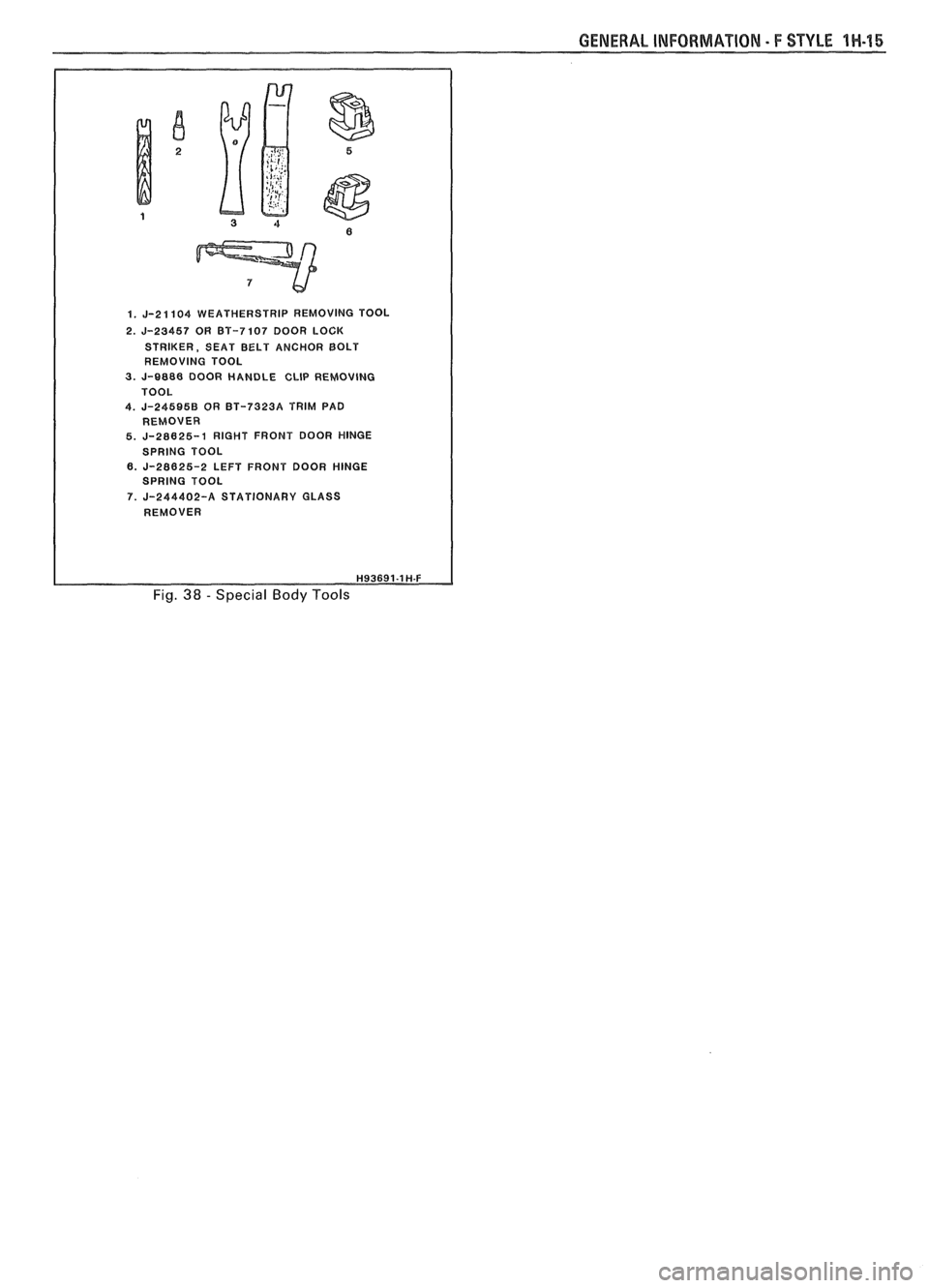
GENERAL INFORMATION - F STYLE 1H-45
1. J-21104 WEATHERSTRIP REMOVING TOOL
2.
J-23457 OR BT-7107 DOOR LOCK
STRIKER, SEAT BELT ANCHOR BOLT
REMOVING TOOL
3. J-8888 DOOR HANDLE CLIP REMOVlNG
4. J-245BSB OR BT-73238 TRIM PAD
REMOVER
5.
J-28625-1 RIGHT FRONT DOOR HINGE
SPRING TOOL
6.
J-28625-2 LEFT FRONT DOOR HINGE
SPRING TOOL
7. J-244402-A STATIONARY GLASS
REMOVER
Fig. 38 - Special Body Tools
Page 1706 of 1825
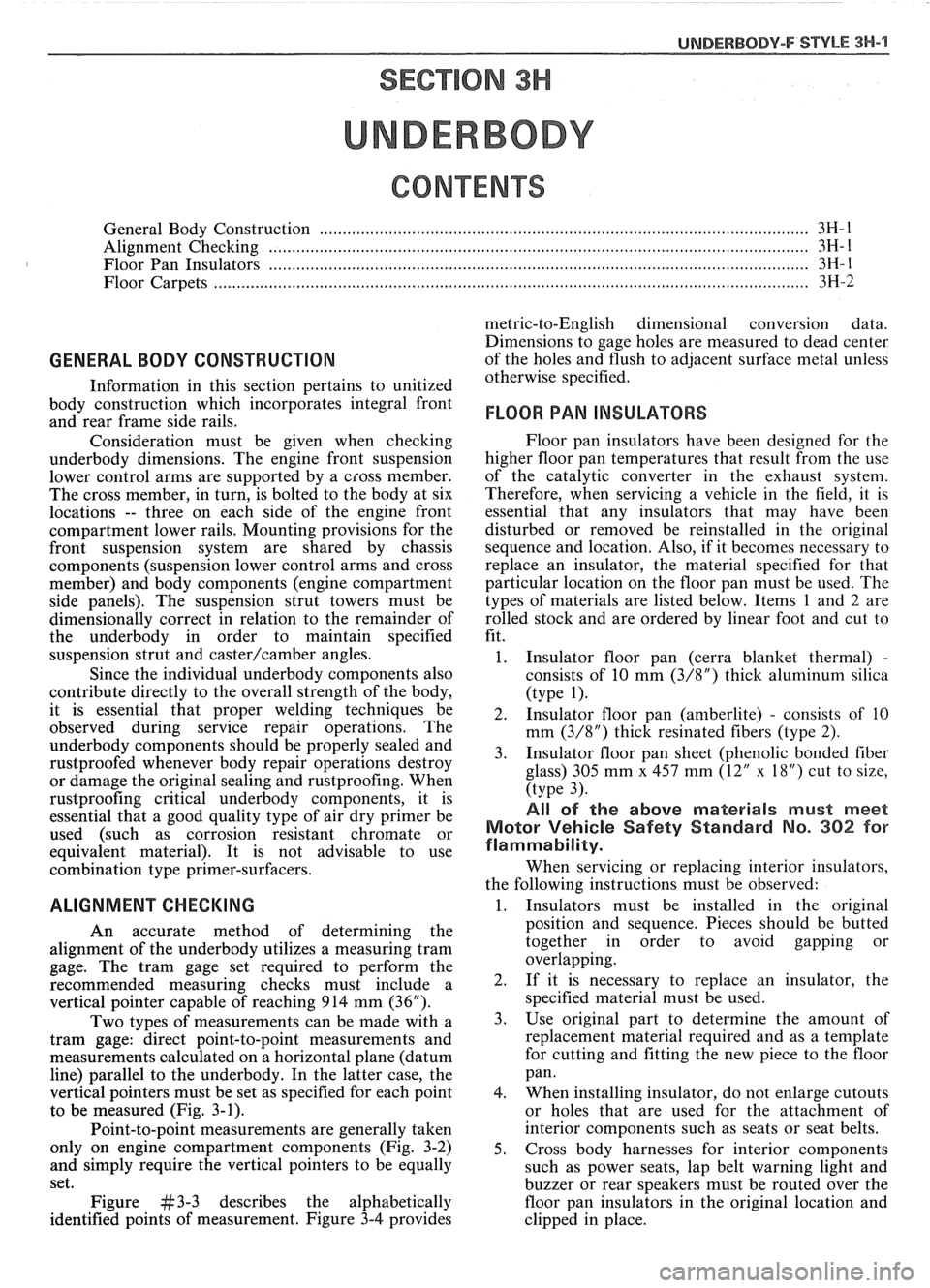
UNDERBODY-F STYLE 3H-1
SECTION 3H
UNDERBODY
CONTENTS
General Body Construction .......................................................................................................... 3H- 1
Alignment Checking ................................................................................................................ 3H- I
Floor Pan Insulators ...................... .. ........................................................................................ 3H- 1
Floor Carpets ................................................................................................................................. 3H-2
metric-to-English dimensional conversion data.
Dimensions to gage holes are measured to dead center
GENERAL BODY CONSTRUCTION of the holes and flush to adjacent surface metal unless
Information in this section pertains to unitized otherwise specified.
body construction which
incorporates integral front
and rear frame side rails. FLOOR PAN INSULATORS
Consideration must be given when checking
underbody dimensions. The engine front suspension
lower control arms are supported by a cross member.
The cross member, in turn, is bolted to the body at six
locations
-- three on each side of the engine front
compartment lower rails. Mounting provisions for the
front suspension system are shared by chassis
components (suspension lower control arms and cross
member) and body components (engine compartment
side panels). The suspension strut towers must be
dimensionally correct in relation to the remainder of
the underbody in order to maintain specified
suspension strut and
castedcamber angles.
Since the individual underbody components also
contribute directly to the overall strength of the body,
it is essential that proper welding techniques be
observed during service repair operations. The
underbody components should be properly sealed and
rustproofed whenever body repair operations destroy
or damage the original sealing and rustproofing. When
rustproofing critical underbody components, it is
essential that a good quality type of air dry primer be
used (such as corrosion resistant chromate or
equivalent material). It is not advisable to use
combination type primer-surfacers.
ALIGNMENT CHECKING
An accurate method of determining the
alignment of the underbody utilizes a measuring tram
gage. The tram gage set required to perform the
recommended measuring checks must include a
vertical pointer capable of reaching 914 mm (36").
Two types of measurements can be made with
a
tram gage: direct point-to-point measurements and
measurements calculated on a horizontal
vlane (datum
line) parallel to the underbody. In the
latter case, the
vertical pointers must be set as specified for each point
to be measured (Fig. 3-1).
Point-to-point measurements are generally taken
only on engine compartment components (Fig. 3-2)
and simply require the vertical pointers to be equally
set.
Figure #3-3 describes the alphabetically
identified points of measurement. Figure 3-4 provides Floor
pan insulators have been designed for the
higher floor pan temperatures that result from the use
of the catalytic converter in the exhaust system.
Therefore, when servicing a vehicle in the field, it is
essential that any insulators that may have been
disturbed or removed be reinstalled in the original
sequence and location. Also, if it becomes necessary to
replace an insulator, the material specified for that
particular location on the floor pan must be used. The
types of materials are listed below. Items 1 and
2 are
rolled stock and are ordered by linear foot and cut to
fit.
1. Insulator floor pan
(cerra blanket thermal) -
consists of 10 mm (3/8") thick aluminum silica
(type 1).
2. Insulator floor pan (amberlite) - consists of 10
mm
(3/8") thick resinated fibers (type 2).
3. Insulator floor pan sheet (phenolic bonded fiber
glass)
305 mm x 457 mm (12" x 18") cut to size,
(type 3).
All of the above materials must meet
Motor Vehicle Safety Standard No. 302 for
flammability.
When servicing or replacing interior insulators,
the following instructions must be observed:
1. Insulators must be installed in the original
position and sequence. Pieces should be butted
together in order to avoid gapping or
overlapping.
2. If it is necessary to replace an insulator, the
specified material must be used.
3. Use original
part to determine the amount of
replacement material required and as a template
for cutting and fitting the new piece to the floor
pan.
4. When installing insulator, do not enlarge cutouts
or holes that are used for the attachment of
interior components such as seats or seat belts.
5. Cross body harnesses for interior components
such as power seats, lap belt warning light and
buzzer or rear speakers must be routed over the
floor pan insulators in the original location and
clipped in place.
Page 1707 of 1825
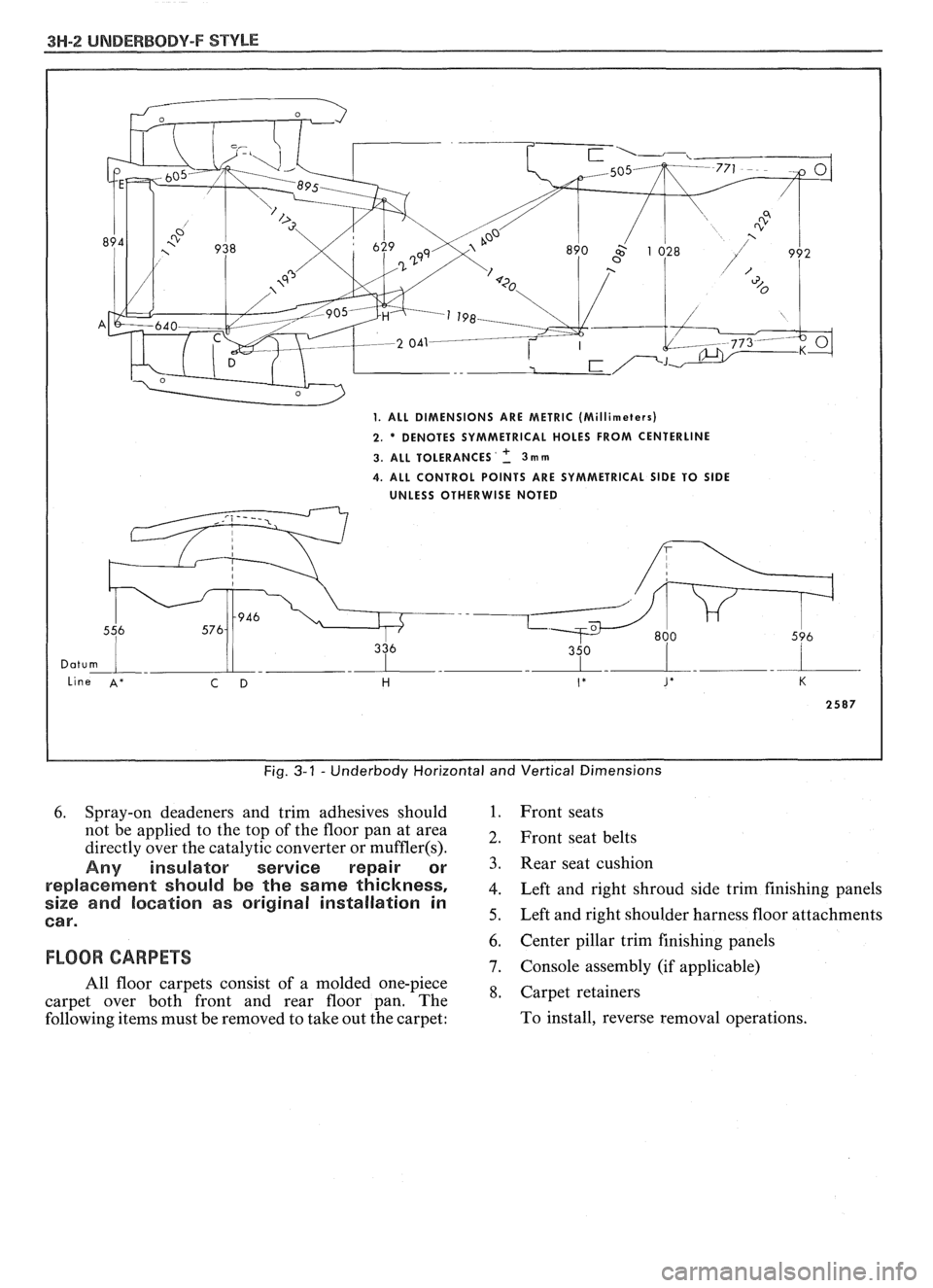
3H-2 UNDERBODY-F STYLE
Fig. 3-1 - Underbody Horizontal and Vertical Dimensions
6. Spray-on deadeners and trim adhesives should 1. Front seats
not be applied to the top of the floor pan at area
2, Front seat belts directly over the catalytic converter or muffler(s).
Any insulator service repair or 3. seat cushion
re~laeement should be the same thickness, 4. Left and right shroud side trim finishing panels size and location as original installation in
Car. 5. Left and right shoulder harness floor attachments
6. Center pillar trim finishing panels
FLOOR CARPETS 7. Console assembly (if applicable)
All floor carpets consist of a molded one-piece
*, Carpet retainers carpet over both front and rear floor pan. The
following items must be removed to take out the carpet: To
install, reverse removal operations.
Page 1710 of 1825
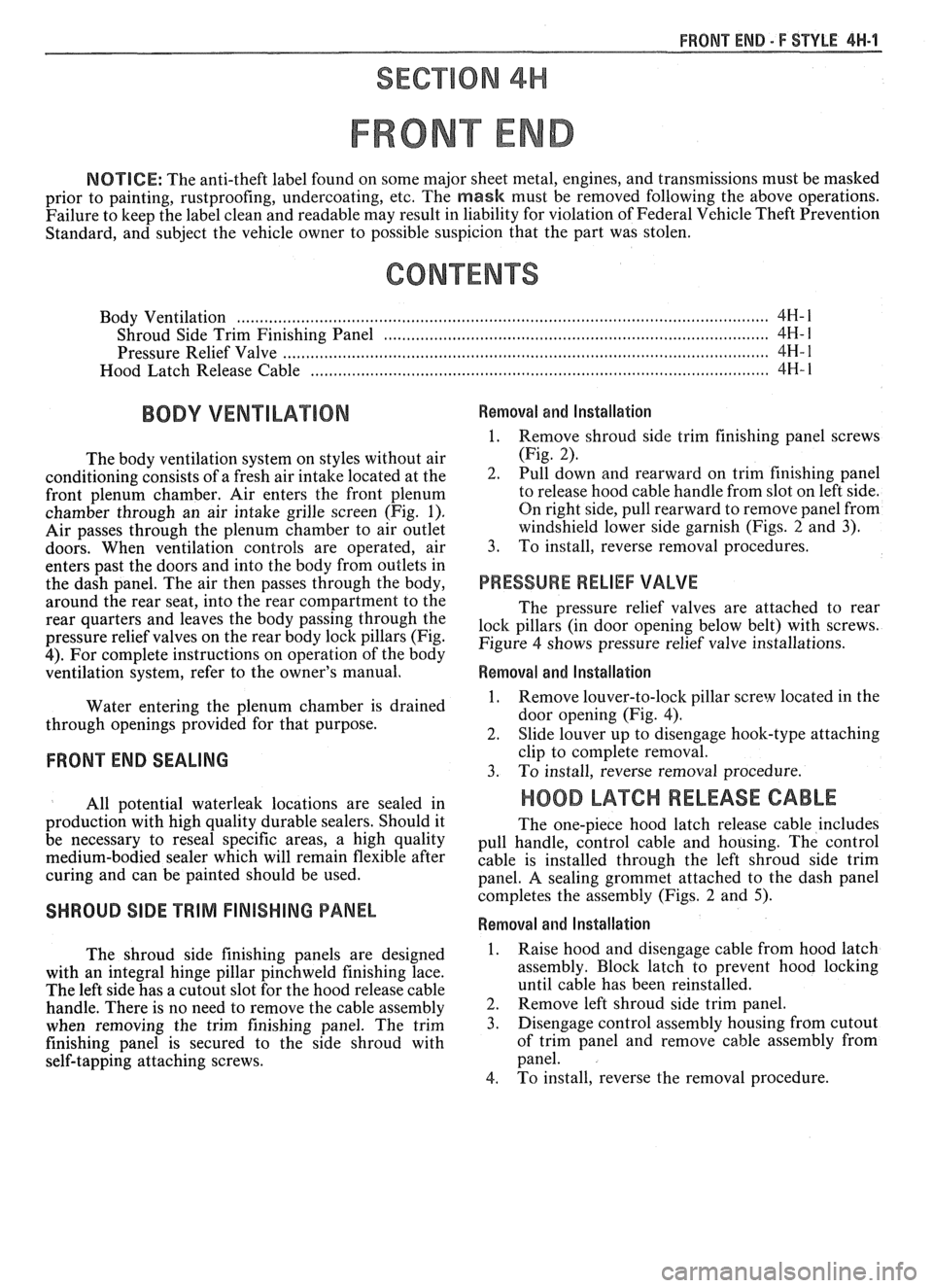
FRONT END - F STYLE 41-1-1
SECTION 4H
FRONT END
NOTICE: The anti-theft label found on some major sheet metal, engines, and transmissions must be masked
prior to painting, rustproofing, undercoating, etc. The
mask must be removed following the above operations.
Failure to keep the label clean and readable may result in liability for violation of Federal Vehicle Theft Prevention
Standard, and subject the vehicle owner to possible suspicion that the part was stolen.
CONTENTS
.............................................................................................................. Body Ventilation 4H- 1
Shroud Side Trim Finishing Panel ................................................................................ 4H- 1
Pressure Relief Valve .................................................................................................. 4H- 1
Hood Latch Release Cable ............................................................................................ 4H- 1
The body ventilation system on styles without air
conditioning consists of a fresh air intake located at the
front plenum chamber. Air enters the front plenum
chamber through an air intake grille screen (Fig.
1).
Air passes through the plenum chamber to air outlet
doors. When ventilation controls are operated, air
enters past the doors and into the body from outlets in
the dash panel. The air then passes through the body,
around the rear seat, into the rear compartment to the
rear quarters and leaves the body passing through the
pressure relief valves on the rear body lock pillars (Fig.
4). For complete instructions on operation of the body
ventilation system, refer to the owner's manual.
Water entering the plenum chamber is drained
through openings provided for that purpose.
FRONT END SEALING
All potential waterleak locations are sealed in
production with high quality durable sealers. Should it
be necessary to reseal specific areas, a high quality
medium-bodied sealer which will remain flexible after
curing and can be painted should be used.
SHROUD SIDE TRIM FINISHING PANEL
Removal and Installation
1. Remove shroud side trim finishing panel screws
(Fig. 2).
2. Pull down and rearward on trim finishing panel
to release hood cable handle from slot on left side.
On right side, pull rearward to remove panel from
windshield lower side garnish (Figs.
2 and 3).
3. To install, reverse removal procedures.
PRESSURE RELIEF VALVE
The pressure relief valves are attached to rear
lock pillars (in door opening below belt) with screws.
Figure
4 shows pressure relief valve installations.
Removal and Installation
1. Remove louver-to-lock pillar screw located in the
door opening (Fig.
4).
2. Slide louver up to disengage hook-type attaching
clip to complete removal.
3. To install, reverse removal procedure.
HOOD LATCH RELEASE CABLE
The one-piece hood latch release cable includes
pull handle, control cable and housing. The control
cable is installed through the left shroud side trim
panel. A sealing grommet attached to the dash panel
completes the assembly (Figs. 2 and
5).
Removal and Installation
The shroud side finishing panels are designed
with an integral hinge pillar pinchweld finishing lace.
The left side has a cutout slot for the hood release cable
handle. There is no need to remove the cable assembly
2.
when removing the trim finishing panel. The trim 3.
finishing panel is secured to the side shroud with
self-tapping attaching screws.
4.
Raise hood and disengage cable from hood latch
assembly. Block latch to prevent hood locking
until cable has been reinstalled.
Remove left shroud side trim panel.
Disengage control assembly housing from cutout
of trim panel and remove
cable assembly from
panel.
To install, reverse the removal procedure.
Page 1714 of 1825
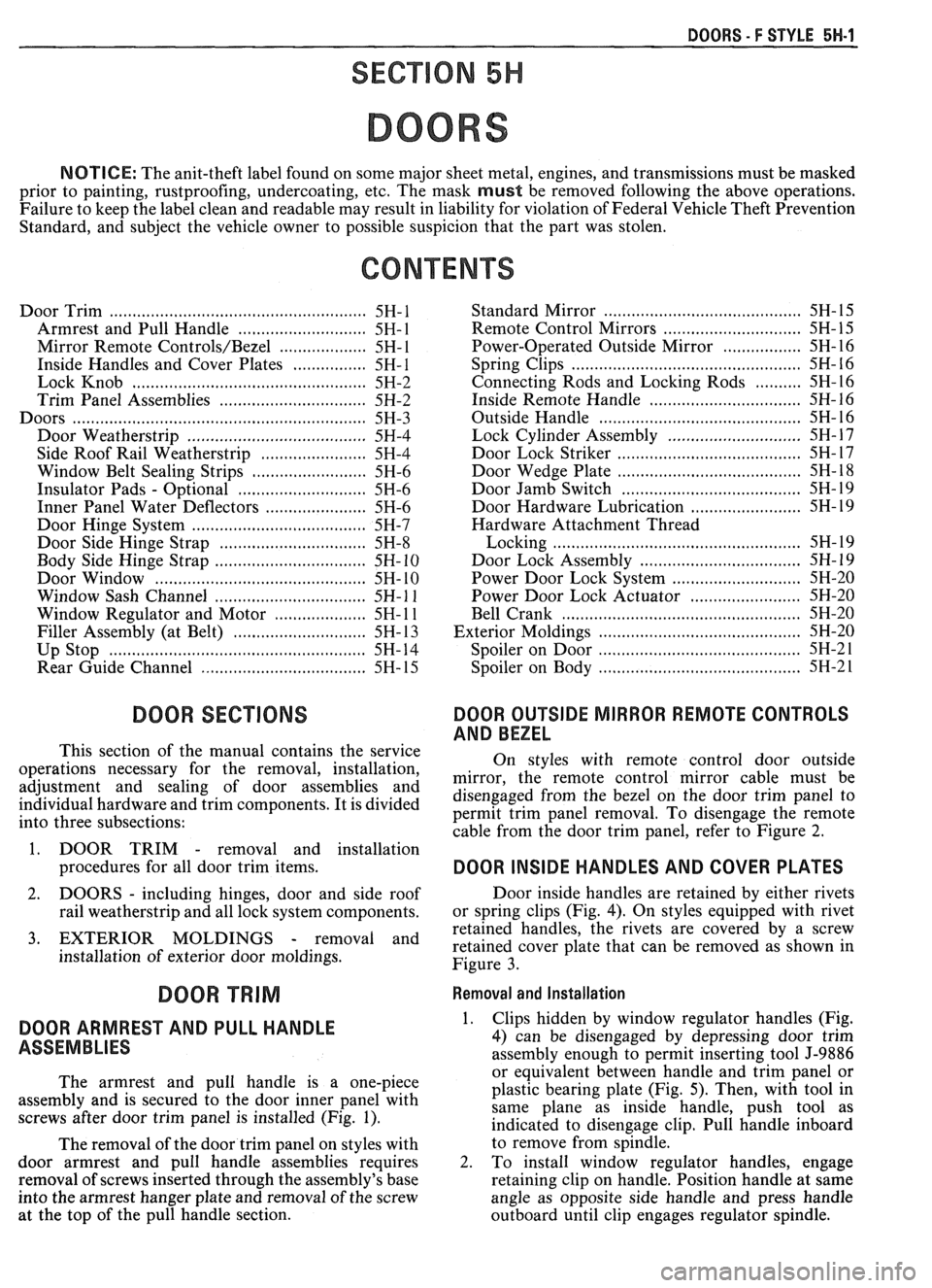
DOORS - F STYLE 5H-1
SEC"610N 5H
DOORS
NOTICE: The anit-theft label found on some major sheet metal, engines, and transmissions must be masked
prior to painting, rustproofing, undercoating, etc. The mask
must be removed following the above operations.
Failure to keep the label clean and readable may result in liability for violation of Federal Vehicle Theft Prevention
Standard, and subject the vehicle owner to possible suspicion that the part was stolen.
Door Trim
...................................................... 5H- 1
Armrest and Pull Handle .......................... 5H- 1
Mirror Remote Controls/Bezel ................... 5H- 1
Inside Handles and Cover Plates ................ 5H- 1
Lock Knob .................................... .... ........... 5H-2
Trim Panel Assemblies .............................. 5H-2
Doors ............................................................ 5H-3
Door Weatherstrip ....................................... 5H-4
Side Roof Rail Weatherstrip ....................... 5H-4
Window Belt Sealing Strips ......................... 5H-6
Insulator Pads - Optional ............................ 5H-6
Inner Panel Water Deflectors ...................... 5H-6
Door Hinge System .................................. .... 5H-7
Door Side Hinge Strap ............................... 5H-8
Body Side Hinge Strap ................................ 5H- 10
Door Window ..................... .. ................... 5H- 10
Window Sash Channel ................................. 5H- 1 1
Window Regulator and Motor .................... 5H- 1 1
Filler Assembly (at Belt) ......................... ... . 5H- 13
Up Stop ............................ .. ...................... 5H- 14
Rear Guide Channel .................................... 5H- 15
DOOR SECnONS
This section of the manual contains the service
operations necessary for the removal, installation,
adjustment and sealing of door assemblies and
individual hardware and trim components. It is divided
into three subsections:
1. DOOR TRIM
- removal and installation
procedures for all door trim items.
2. DOORS - including hinges, door and side roof
rail weatherstrip and all lock system components.
3. EXTERIOR MOLDINGS - removal and
installation of exterior door moldings. Standard Mirror
......................................... 5H- 15
........................... Remote
Control Mirrors 5H- 15
Power-Operated Outside Mirror ................. 5H-16
Spring Clips .................................................. 5H- 16
Connecting Rods and Locking Rods .......... 5H-16
Inside Remote Handle ................................ 5H- 16
......................................... Outside Handle 5H- 16
............................. Lock Cylinder Assembly 5H- 17
...................................... Door Lock Striker 5H- 17
....................................... Door Wedge Plate 5H- 18
....................................... Door Jamb Switch 5H- 19
........................ Door Hardware Lubrication 5H- 19
Hardware Attachment Thread
.................................................. Locking 5H- 19
................................... Door Lock Assembly 5H- 19
............................ Power Door Lock System 5H-20
........................ Power Door Lock Actuator 5H-20
............. .................................... Bell Crank ... 5H-20
.......................................... Exterior Moldings 5H-20
.......................................... Spoiler on Door 5H-21
.......................................... Spoiler on Body 5H-2 1
DOOR OUTSIDE MIRROR REMOTE CONTROLS
AND BEZEL
On styles with remote control door outside
mirror, the remote control mirror cable must be
disengaged from the bezel on the door trim panel to
permit trim panel removal. To disengage the remote
cable from the door trim panel, refer to Figure
2.
DOOR INSIDE HANDLES AND COVER PLATES
Door inside handles are retained by either rivets
or spring clips (Fig.
4). On styles equipped with rivet
retained handles, the rivets are covered by a screw
retained cover plate that can be removed as shown in
Figure
3.
DOOR TRIM Removal and Installation
DOOR ARMREST AND PULL HANDLE 1.
ASSEMBLIES
The armrest and pull handle is a one-piece
assembly and is secured to the door inner panel with
screws after door trim panel is installed (Fig. 1). Clips hidden
by window regulator handles (Fig,
4) can be disengaged by depressing door trim
assembly enough to permit inserting tool J-9886
or equivalent between handle and trim panel or
plastic bearing plate (Fig.
5). Then, with tool in
same plane as inside handle, push tool as
indicated to disengage clip. Pull handle inboard
The removal of the door trim panel on styles with to
remove from
s$n>le. -
door armrest and pull handle assemblies requires 2. To install window regulator handles, engage
removal of screws inserted through the assembly's base retaining clip on handle. Position handle at same
into the armrest hanger plate and removal of the screw angle as opposite side handle and press handle
at the top of the pull handle section.
outboard until clip engages regulator spindle.
Page 1716 of 1825
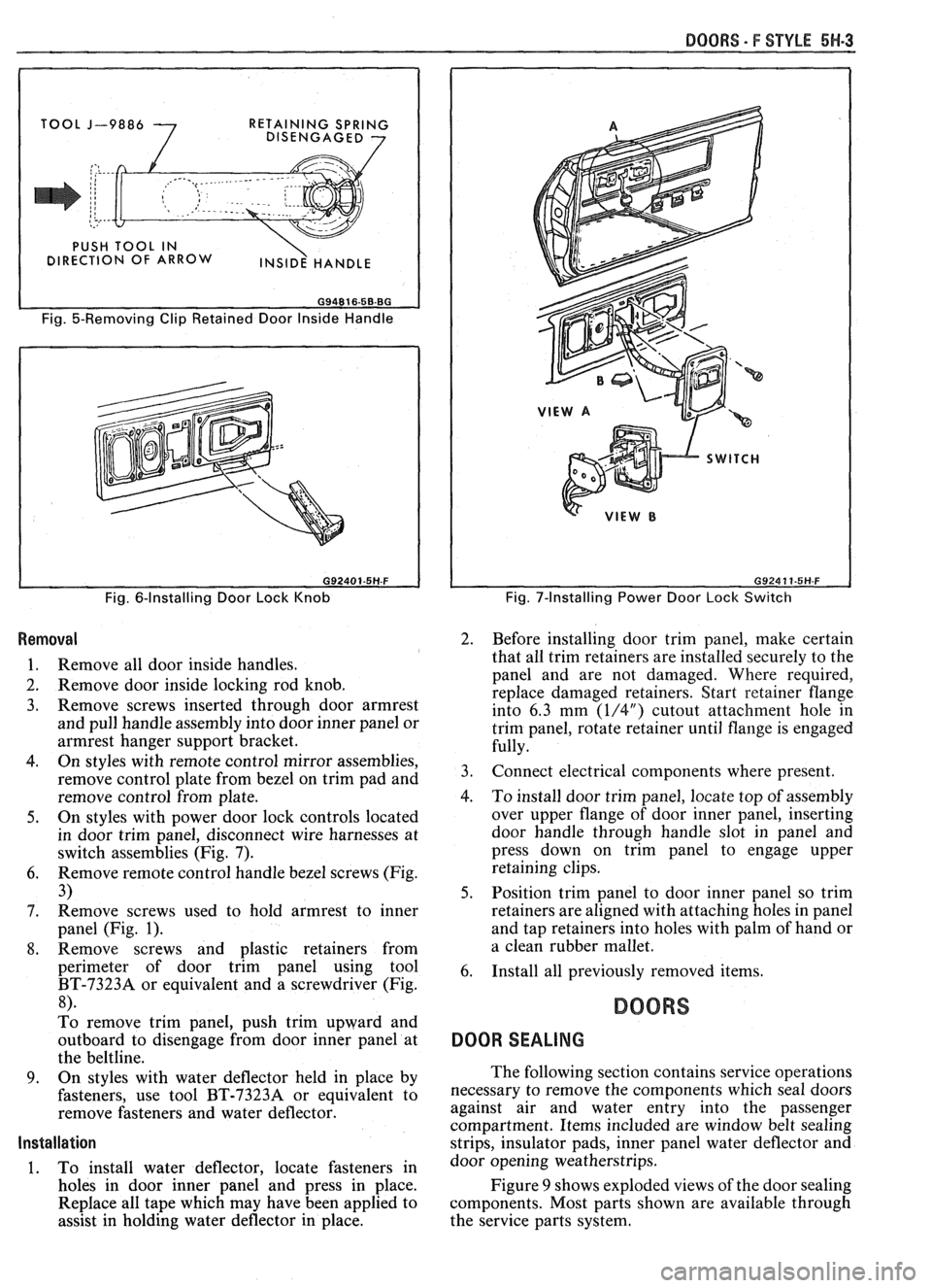
BOORS - F STYLE 5H-3
I
J-9886
7
RETAINING SPRING
DISENGAGED 7
Fig. 5-Removing Clip Retained Door Inside Handle
Fig. 6-Installing Door Lock Knob
Removal
1. Remove all door inside handles.
2. Remove door inside locking rod knob.
3. Remove screws inserted through door armrest
and pull handle assembly into door inner panel or
armrest hanger support bracket.
4. On styles with remote control mirror assemblies,
remove control plate from bezel on trim pad and
remove control from plate.
5. On styles with power door lock controls located
in door trim panel, disconnect wire harnesses at
switch assemblies (Fig. 7).
6. Remove remote control handle bezel screws (Fig.
3)
7. Remove
screws used to hold armrest to inner
panel (Fig.
1).
8. Remove screws and plastic retainers from
perimeter of door trim panel using tool
BT-73238 or equivalent and a screwdriver (Fig.
8).
To remove trim panel, push trim upward and
outboard to disengage from door inner panel at
the beltline.
9. On styles with water deflector held in place by
fasteners, use tool BT-7323A or equivalent to
remove fasteners and water deflector.
Installation
1. To install water deflector, locate fasteners in
holes in door inner panel and press in place.
Replace all tape which may have been applied to
assist in holding water deflector in place.
Fig. 7-Installing Power Door Lock Switch
2. Before installing door trim panel, make certain
that all trim retainers are installed securely to the
panel and are not damaged. Where required,
replace damaged retainers. Start retainer Range
into 6.3 mm
(1/4") cutout attachment hole in
trim panel, rotate retainer until flange is engaged
fully.
3. Connect electrical components where present.
4. To install door trim panel, locate top of assembly
over upper flange of door inner panel, inserting
door handle through handle slot in panel and
press down on trim panel to engage upper
retaining clips.
5. Position trim panel to door inner panel so trim
retainers are aligned with attaching holes in panel
and tap retainers into holes with palm of hand or
a clean rubber mallet.
6. Install all previously removed items.
BOORS
DOOR SEALING
The following section contains service operations
necessary to remove the components which seal doors
against air and water entry into the passenger
compartment. Items included are window belt sealing
strips, insulator pads, inner panel water deflector and
door opening weatherstrips.
Figure
9 shows exploded views of the door sealing
components. Most parts shown are available through
the service parts system.
Page 1717 of 1825
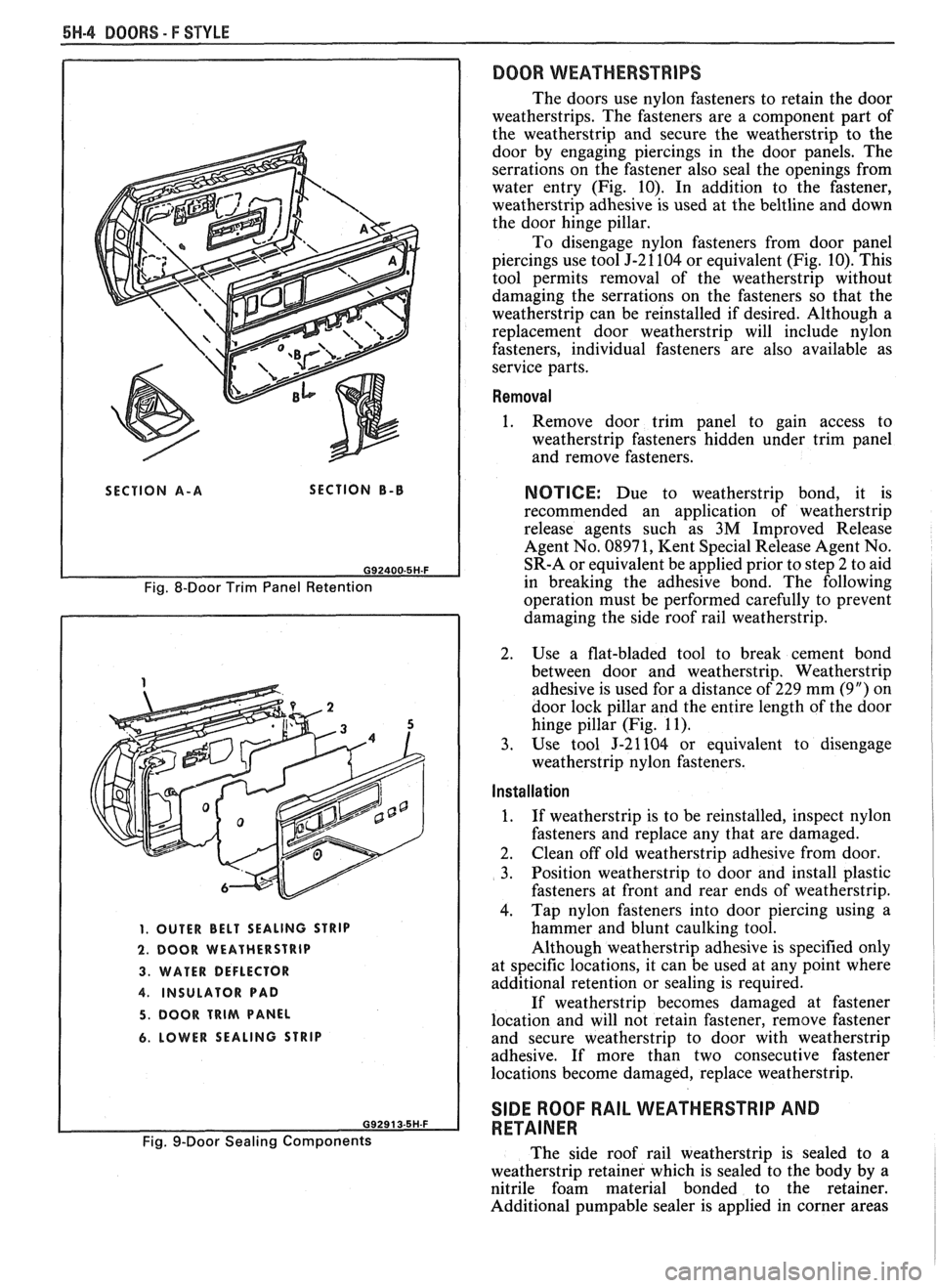
5H.4 DOORS - F STYLE
SECTION A-A SECTION B-B
Fig. 8-Door Trim Panel Retention
1. OUTER BELT SEALING STRIP
2. DOOR WEATHERSTRIP
3. WATER DEFLECTOR
4. INSULATOR PAD
5. DOOR TRIM PANEL
6. LOWER SEALING STRIP
Fig. 9-Door Sealing Components
DOOR WEATHERSTRIPS
The doors use nylon fasteners to retain the door
weatherstrips. The fasteners are a component part of
the weatherstrip and secure the weatherstrip to the
door by engaging piercings in the door panels. The
serrations on the fastener also seal the openings from
water entry (Fig. 10). In addition to the fastener,
weatherstrip adhesive is used at the
beltline and down
the door hinge pillar.
To disengage nylon fasteners from door panel
piercings use tool J-21104 or equivalent (Fig. 10). This
tool permits removal of the weatherstrip without
damaging the serrations on the fasteners so that the
weatherstrip can be reinstalled if desired. Although a
replacement door weatherstrip will include nylon
fasteners, individual fasteners are also available as
service parts.
Removal
1. Remove door trim panel to gain access to
weatherstrip fasteners hidden under trim panel
and remove fasteners.
NOTICE: Due to weatherstrip bond, it is
recommended an application of weatherstrip
release agents such as
3M Improved Release
Agent No. 08971, Kent Special Release Agent No.
SR-A or equivalent be applied prior to step 2 to aid
in breaking the adhesive bond. The following
operation must be performed carefully to prevent
damaging the side roof rail weatherstrip.
2. Use a flat-bladed tool to break cement bond
between door and weatherstrip. Weatherstrip
adhesive is used for a distance of 229 mm (9") on
door lock pillar and the entire length of the door
hinge pillar (Fig. 11).
3. Use tool J-21104 or equivalent to disengage
weatherstrip nylon fasteners.
Installation I 1
1. If weatherstrip is to be reinstalled, inspect nylon
fasteners and replace any that are damaged.
2. Clean
off old weatherstrip adhesive from door.
3. Position weatherstrip to door and install plastic
fasteners at front and rear ends of weatherstrip.
4. Tap
nylon fasteners into door piercing using a
hammer and blunt caulking tool.
Although weatherstrip adhesive is specified only
at specific locations, it can be used at any point where
additional retention or sealing is required.
If weatherstrip becomes damaged at fastener
location and will not retain fastener, remove fastener
and secure weatherstrip to door with weatherstrip
adhesive. If more than two consecutive fastener
locations become damaged, replace weatherstrip.
SIDE ROOF RAIL WEATHERSTRIP AND
RETAINER
The side roof rail weatherstrip is sealed to a
weatherstrip retainer which is sealed to the body by a
nitrile foam material bonded to the retainer.
Additional
pumpable sealer is applied in corner areas
Page 1719 of 1825
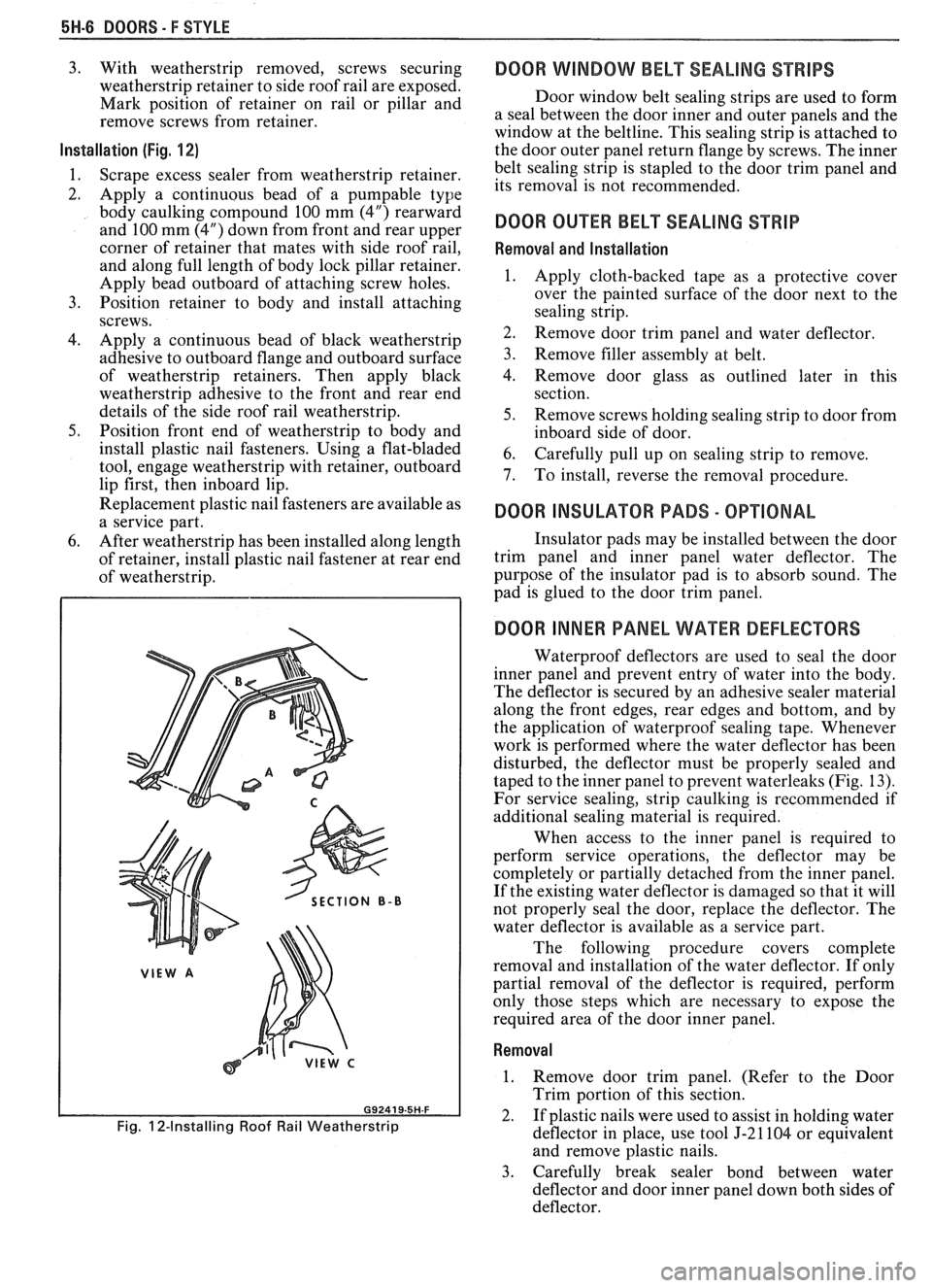
5W-8 BOORS - F STYLE
3. With weatherstrip removed, screws securing
weatherstrip retainer to side roof rail are exposed.
Mark position of retainer on rail or pillar and
remove screws from retainer.
Installation (Fig. 1 2)
1.
Scrape excess sealer from weatherstrip retainer.
2. Apply a continuous bead of a
pumpable type
body caulking compound 100 mm (4") rearward
and 100 mm (4") down from front and rear upper
corner of retainer that mates with side roof rail,
and along full length of body lock pillar retainer.
Apply bead outboard of attaching screw holes.
3. Position retainer to body and install attaching
screws.
4. Apply a continuous bead of black weatherstrip
adhesive to outboard flange and outboard surface
of weatherstrip retainers. Then apply black
weatherstrip adhesive to the front and rear end
details of the side roof rail weatherstrip.
5. Position front end of weatherstrip to body and
install plastic nail fasteners. Using a flat-bladed
tool, engage weatherstrip with retainer, outboard
lip first, then inboard lip.
Replacement plastic nail fasteners are available as
a service part.
6. After weatherstrip has been installed along length
of retainer, install plastic nail fastener at rear end
of weatherstrip.
SECTION B-B
Fig. 12-Installing Roof Rail Weatherstrip
DOOR WINDOW BELT SEALING STRIPS
Door window belt sealing strips are used to form
a seal between the door inner and outer panels and the
window at the beltline. This sealing strip is attached to
the door outer panel return flange by screws. The inner
belt sealing strip is stapled to the door trim panel and
its removal is not recommended.
DOOR OUER BELT SEALING STRIP
Removal and Installation
1.
Apply cloth-backed tape as a protective cover
over the painted surface of the door next to the
sealing strip.
2. Remove door trim panel and water deflector.
3. Remove filler assembly at belt.
4. Remove door glass as outlined later in this
section.
5. Remove screws holding sealing strip to door from
inboard side of door.
6. Carefully pull up on sealing strip to remove.
7. To install, reverse the removal procedure.
DOOR INSULAWR PADS - OPTIONAL
Insulator pads may be installed between the door
trim panel and inner panel water deflector. The
purpose of the insulator pad is to absorb sound. The
pad is glued to the door trim panel.
DOOR INNER PANEL WATER DEFLECTORS
Waterproof deflectors are used to seal the door
inner panel and prevent entry of water into the body.
The deflector is secured by an adhesive sealer material
along the front edges, rear edges and bottom, and by
the application of waterproof sealing tape. Whenever
work is performed where the water deflector has been
disturbed, the deflector must be properly sealed and
taped to the inner panel to prevent waterleaks (Fig. 13).
For service sealing, strip caulking is recommended if
additional sealing material
is required.
When access to the inner panel is required to
perform service operations, the deflector may be
completely or partially detached from the inner panel.
If the existing water deflector is damaged so that it will
not properly seal the door, replace the deflector. The
water deflector is available as a service part.
The following procedure covers complete
removal and installation of the water deflector. If only
partial removal of the deflector is required, perform
only those steps which are necessary to expose the
required area of the door inner panel.
Removal
1. Remove door trim panel. (Refer to the Door
Trim portion of this section.
2. If plastic nails were used to assist in holding water
deflector in place, use tool J-21104 or equivalent
and remove plastic nails.
3. Carefully break sealer bond between water
deflector and door inner panel down both sides of
deflector.